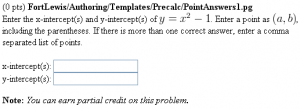PointAnswers1: Difference between revisions
(Created page with '<h2>Answer is a Point or a List of Points</h2> <p style="background-color:#eeeeee;border:black solid 1px;padding:3px;"> This PG code shows how to evaluate answers that are point…') |
(add historical tag and give links to newer problems.) |
||
| (7 intermediate revisions by 3 users not shown) | |||
| Line 1: | Line 1: | ||
{{historical}} | |||
<p style="font-size: 120%;font-weight:bold">This problem has been replaced with [https://openwebwork.github.io/pg-docs/sample-problems/Algebra/PointAnswers.html a newer version of this problem]</p> | |||
<h2>Answer is a Point or a List of Points</h2> | <h2>Answer is a Point or a List of Points</h2> | ||
<p style="background-color:# | [[File:PointAnswers1.png|300px|thumb|right|Click to enlarge]] | ||
<p style="background-color:#f9f9f9;border:black solid 1px;padding:3px;"> | |||
This PG code shows how to evaluate answers that are points or lists of points. | This PG code shows how to evaluate answers that are points or lists of points. | ||
</p> | </p> | ||
* File location in OPL: [https://github.com/openwebwork/webwork-open-problem-library/blob/master/OpenProblemLibrary/FortLewis/Authoring/Templates/Precalc/PointAnswers1.pg FortLewis/Authoring/Templates/Precalc/PointAnswers1.pg] | |||
* PGML location in OPL: [https://github.com/openwebwork/webwork-open-problem-library/blob/master/OpenProblemLibrary/FortLewis/Authoring/Templates/Precalc/PointAnswers1_PGML.pg FortLewis/Authoring/Templates/Precalc/PointAnswers1_PGML.pg] | |||
<br clear="all" /> | |||
<p style="text-align:center;"> | <p style="text-align:center;"> | ||
[[SubjectAreaTemplates|Templates by Subject Area]] | [[SubjectAreaTemplates|Templates by Subject Area]] | ||
| Line 16: | Line 21: | ||
<tr valign="top"> | <tr valign="top"> | ||
<th> PG problem file </th> | <th style="width: 40%"> PG problem file </th> | ||
<th> Explanation </th> | <th> Explanation </th> | ||
</tr> | </tr> | ||
| Line 43: | Line 48: | ||
loadMacros( | loadMacros( | ||
'PGstandard.pl', | |||
'MathObjects.pl', | |||
'contextLimitedPoint.pl', | |||
'PGML.pl', | |||
'PGcourse.pl' | |||
); | ); | ||
| Line 65: | Line 72: | ||
<td style="background-color:#ffffdd;border:black 1px dashed;"> | <td style="background-color:#ffffdd;border:black 1px dashed;"> | ||
<pre> | <pre> | ||
Context( | Context('LimitedPoint'); | ||
$f = Compute( | $f = Compute('x^2-1'); | ||
$xint = List( Point( | $xint = List( Point('(1,0)'), Point('(-1,0)') ); | ||
$yint = List( Point('(0,-1)') ); | |||
$yint = List( Point( | |||
</pre> | </pre> | ||
</td> | </td> | ||
| Line 81: | Line 87: | ||
points as if they were vectors). The x-intercepts are clearly a | points as if they were vectors). The x-intercepts are clearly a | ||
list of points. We used a list with only one element for the y-intercepts | list of points. We used a list with only one element for the y-intercepts | ||
so that a student who mistakenly enters two points will not | so that a student who mistakenly enters two points will be told | ||
a | their second point is incorrect. If we did not use a list for | ||
the y-intercepts, a student who enters two points would be given | |||
an error message instead. | |||
</p> | </p> | ||
</td> | </td> | ||
| Line 92: | Line 100: | ||
<td style="background-color:#ffdddd;border:black 1px dashed;"> | <td style="background-color:#ffdddd;border:black 1px dashed;"> | ||
<pre> | <pre> | ||
BEGIN_PGML | |||
Enter the [`x`]-intercept(s) and [`y`]-intercept(s) | |||
Enter the x-intercept(s) and y-intercept(s) | of [` y = [$f] `]. Enter a point as [` (a,b) `], | ||
of | including the parentheses. If there is more | ||
including the parentheses. If there is more | than one correct answer, enter a comma | ||
than one correct answer, enter a comma | |||
separated list of points. | separated list of points. | ||
+ [`x`]-intercept(s): [_________________]{$xint} | |||
+ [`y`]-intercept(s): [_________________]{$yint} | |||
$ | |||
[@ helpLink('points') @]* | |||
END_PGML | |||
</pre> | </pre> | ||
<td style="background-color:# | <td style="background-color:#ffcccc;padding:7px;"> | ||
<p> | <p> | ||
<b> | <b>Main Text:</b> | ||
Be sure to tell students the proper syntax for how to enter their answers. | |||
</p> | </p> | ||
</td> | </td> | ||
| Line 139: | Line 127: | ||
<td style="background-color:#ddddff;border:black 1px dashed;"> | <td style="background-color:#ddddff;border:black 1px dashed;"> | ||
<pre> | <pre> | ||
BEGIN_PGML_SOLUTION | |||
Solution explanation goes here. | Solution explanation goes here. | ||
END_PGML_SOLUTION | |||
ENDDOCUMENT(); | ENDDOCUMENT(); | ||
</pre> | </pre> | ||
| Line 164: | Line 146: | ||
[[Category:Top]] | [[Category:Top]] | ||
[[Category: | [[Category:Sample Problems]] | ||
[[Category:Subject Area Templates]] | |||
Latest revision as of 10:08, 18 July 2023
This problem has been replaced with a newer version of this problem
Answer is a Point or a List of Points

This PG code shows how to evaluate answers that are points or lists of points.
- File location in OPL: FortLewis/Authoring/Templates/Precalc/PointAnswers1.pg
- PGML location in OPL: FortLewis/Authoring/Templates/Precalc/PointAnswers1_PGML.pg
| PG problem file | Explanation |
|---|---|
|
Problem tagging: |
|
DOCUMENT(); loadMacros( 'PGstandard.pl', 'MathObjects.pl', 'contextLimitedPoint.pl', 'PGML.pl', 'PGcourse.pl' ); TEXT(beginproblem()); |
Initialization:
We only need to load |
Context('LimitedPoint');
$f = Compute('x^2-1');
$xint = List( Point('(1,0)'), Point('(-1,0)') );
$yint = List( Point('(0,-1)') );
|
Setup:
We could have used |
BEGIN_PGML
Enter the [`x`]-intercept(s) and [`y`]-intercept(s)
of [` y = [$f] `]. Enter a point as [` (a,b) `],
including the parentheses. If there is more
than one correct answer, enter a comma
separated list of points.
+ [`x`]-intercept(s): [_________________]{$xint}
+ [`y`]-intercept(s): [_________________]{$yint}
[@ helpLink('points') @]*
END_PGML
|
Main Text: Be sure to tell students the proper syntax for how to enter their answers. |
BEGIN_PGML_SOLUTION Solution explanation goes here. END_PGML_SOLUTION ENDDOCUMENT(); |
Solution: |